Author Archives: admin
Studio Pottery Price Guide
As you may be able to tell, one of my passions is pottery & porcelain. I identified Studio Pottery as a great place to find high value bargains a long while back, since people generally can’t tell the difference between a fantastic piece & a mediocre one.
This ebook concentrates on only the desirable potters, over 200 of them, and gives examples of their work, marks, and values.

Book currently unavailable
(more…)
How to Find Bargain Antiques
This is an ebook I prepared in 2003 explaining how what I had found useful in finding bargain antiques & collectables, something that I had managed to learn with some degree of success.
More importantly I went on to explain how I thought that this could be much better applied to the internet & auction sites, and it was using these very same methods that in 2006 I bought an antique Worcester jug, incorrectly described, for £100 on eBay – I subsequently sold it at Bonhams for a staggering £47,000!

Book currently unavailable
(more…)
Silver Hallmarks Guide
Our ebook shows you a method to quickly estimate the date of any piece of English silver without the need to look up the hallmarks in your hallmark book!

Book currently unavailable
(more…)
Silver Makers Hallmarks
This section will concentrate on the silver hallmarks of different silversmiths & manufacturers. It will cover makers from all eras but will primarily concentrate on silver hallmarks from 18th Century Silver & 19th Century Silversmiths.
English Silver Hallmarks
A comprehensive guide to English silver hallmarks covering the different standard marks, the assay offices, and other special marks like duty marks and commemorative marks.
We will cover silver makers hallmarks in their own right.
As mentioned earlier, silver hallmarks were originally introduced in 1300 by a Statute of Edward I, which became necessary because precious metals are not used in their pure form, but rather have other metals added to them.
Because silver has a high value, it is clear that by adding less silver & adding more copper, that the maker could pass off an item for more money than it was actually worth. By doing this, unscrupulous silversmiths could make significant profits.
Consequently the hallmarking system was necessary.
A typical set of British silver hallmarks includes the Standard Mark, the City Mark, the Date Letter, possibly a duty mark (see below) Duty Mark, and a Maker’s Mark.
The Standard Mark:

This is the standard English lion passant gardant silver standard mark that you will find on almost all English silver. The only other mark that you might find is that of the Britannia Standard, introduced in 1697 & removed in 1720, which denoted a silver content of 95.84% silver. You can see this hallmark below.

This is an image of the Britannia hallmark which has been re-introduced as an optional mark since 1999 to symbolise the finest quality English silver (.958 grade)
The City Mark:
Each city that had an assay office had it’s own unique mark to identify where any piece of silver had been produced, you can see these below:
London Hallmark:
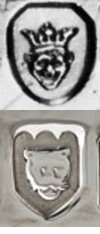
The London silver hallmark was used from 1300 & is represented by a lions head. The crowned head was used prior to 1821, after this date the London hallmark is the lion head without its crown, as in the bottom image.
Birmingham:

The anchor mark was used from 1773 when the assay office opened. In the 20th Century the anchor mark is upright for silver & on it’s side for gold, from 1999 it is on it’s side for both the silver hallmark & the gold hallmark.
Chester:

The Chester assay office produced plate from the 15th Century but was not regulated until the 17th Century. The mark was as shown from 1686 – 1701 when it was replaced with a similar shield, half with wheatsheafs, the other half with 3 lions passant. The 3 wheatsheafs were reintroduced from 1779 until the office shut in 1961.
Dublin:
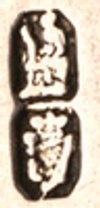
The Dublin silver hallmark has always been the harp (the bottom of the 2 images), with the figure of Hibernia (the uppermost image) being added in 1731. The Dublin assay office opened in 1636 & is still active today.
Edinburgh:
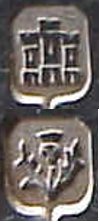
The assay mark for Edinburgh is a 3 towered castle. From 1759 it has been accompanied with the Scottish thistle shown in the second picture to the left, which was replaced with the lion rampant in 1975.
Exeter:

This mark, the three towered castle (see also Edinburgh) was used from 1701 until the closure of the assay office in 1882. An earlier mark of an X in a shield surmounted by a crown had been used previously in Exeter.
Glasgow:
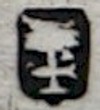
The hallmark for Glagow is based on the Arms of the city, consisting of a Tree, Bird, Bell and Ring. The mark dates from the late 17th Century, the office opening in 1681, and often appears with a lion rampant. The Scottish thistle was added in 1914, the office shut in 1964.
Newcastle:
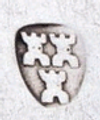
The Newcastle assay office was in operation from 1702 until its closure in 1884
Sheffield:
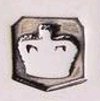
The Sheffield hallmark of a Crown was in use from 1773 until 1974 when it was replaced by a Rose. The office remains open today. Interestingly the Sheffield & Birmingham hallmarks were derived from their partitioning for respective assay offices after they were ommitted by accident from official documents. They used to meet at a pub called the crown & anchor during this time.
York Hallmark:
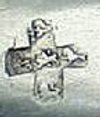
The York hallmark existed originally as a leopards head, then a half rose, until eventually this hallmark was used from 1701 until the assay office closed in 1856.
There was also an office in Norwich but silver from Norwich is very rare, it had stopped making plate by around 1700.
Date Letters:
The date letters are of course very important in determining when any piece of English silver was made, but for these silver hallmarks, which are quite numerous, we recommend that you should buy a silver hallmarks book from our recommended books section. They are quite inexpensive & are always useful to have around.
Duty Marks:

Duty marks were added in 1784 as a tax to pay for the war with America. The tax lasted until 1890! The duty marks above were used during the following dates:
Mark a (the only Kings head facing left) was used in 1784 – 85
Mark b was used between 1786 & 1821
Mark c was used between 1822 & 1833
Mark d was used between 1834 & 1837
Mark e (the only Queens head) was used between 1838 & 1890
The only other hallmarks that you will find on English & British silver are the makers marks, which we will cover in a different section, and commemorative marks such as for the Queens coronation, silver jubilee, etc.
We hope that you find the above look at English silver hallmarks interesting & useful!
Silver Hallmarks
Silver hallmarks are an invaluable aid to collectors and dealers for identifying the date & maker of antique silver, and indeed any piece of silver made in England.

modern silver hallmarks
Hallmarks on silver were first introduced in the UK in 1300 as a method of proving that the silver object contained the correct amount of silver, since pure silver is a very soft metal and consequently any object made from silver requires some base metal to be added to it to strengthen it.
In these early days it was not uncommon for silver objects to be melted down and converted into coinage, and so it was imperative that the silver used was of a sufficient grade, especially with continental silver containing a much lower percentage of silver.
Silver Hallmarks were the answer to this problem.
Any piece of silver had to be officially approved to be of a high enough silver content, and would be given it’s hallmark only when this was the case.
As a consequence the hallmark became a standard of quality and assurance, and the presence of a hallmark on a silver object was an official seal of approval.
English silver, or Sterling silver is often referred to as solid silver, but it does in fact contain 7.5% copper, so it is 92.5% pure, which is why modern silver often has a .925 mark stamped into it. Continental silver is often only 80% pure.
English Silver Hallmarks evolved over time, with the eventual inclusion of the standard or sterling mark, the assay office, the year of manufacture, the maker, and sometimes an additional mark for special reasons.
All of these silver hallmarks can help in identifying exactly when and by who any piece was made, which is not only helpful to collectors of antique silver, but also offers a fascinating dimension to any old silver object that you may possess.
Privacy Policy
If you require any more information or have any questions about our privacy policy, please feel free to contact us by email at contact@silverhallmarks.org.uk
At this site, the privacy of our visitors is of extreme importance to us. This privacy policy document outlines the types of personal information is received and collected by this site and how it is used.
Log Files
Like many other Web sites, this site makes use of log files. The information inside the log files includes internet protocol ( IP ) addresses, type of browser, Internet Service Provider ( ISP ), date/time stamp, referring/exit pages, and number of clicks to analyze trends, administer the site, track users movement around the site, and gather demographic information. IP addresses, and other such information are not linked to any information that is personally identifiable.
Cookies and Web Beacons
this site does use cookies to store information about visitors preferences, record user-specific information on which pages the user access or visit, customize Web page content based on visitors browser type or other information that the visitor sends via their browser.
DoubleClick DART Cookie
.:: Google, as a third party vendor, uses cookies to serve ads on this site. .:: Google’s use of the DART cookie enables it to serve ads to users based on their visit to this site and other sites on the Internet. .:: Users may opt out of the use of the DART cookie by visiting the Google ad and content network privacy policy at the following URL – http://www.google.com/privacy_ads.html
Some of our advertising partners may use cookies and web beacons on our site. Our advertising partners include …. Google Adsense These third-party ad servers or ad networks use technology to the advertisements and links that appear on this site send directly to your browsers. They automatically receive your IP address when this occurs. Other technologies ( such as cookies, JavaScript, or Web Beacons ) may also be used by the third-party ad networks to measure the effectiveness of their advertisements and / or to personalize the advertising content that you see.
This site has no access to or control over these cookies that are used by third-party advertisers.
You should consult the respective privacy policies of these third-party ad servers for more detailed information on their practices as well as for instructions about how to opt-out of certain practices. this site’s privacy policy does not apply to, and we cannot control the activities of, such other advertisers or web sites.
If you wish to disable cookies, you may do so through your individual browser options. More detailed information about cookie management with specific web browsers can be found at the browsers’ respective websites.

